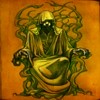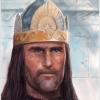Above post was just my gut-feeling on issue, so I've checked the lore ... it's a bit ambiguous, and scattered, and I believe that's why most people consider Angmar a dead realm after the escape of the Witch-king.
The most detailed accounts are to be found in the appendices to RotK, especially Appendix A,I (the history of Arnor and Gondor) with info related to both the Northern and the Southern Kingdoms.
In the year 1973 ...
... Eärnur came to the Grey Havens ... Then Cirdan summoned all that would come to him, from Lindon or Arnor, and when all was ready the host crossed the Lune and marched north to challenge the Witch-king of Angmar. He was now dwelling, it is said, in Fornost, which he had filled with evil folk, usurping the house and the rule of the Kings. In his pride he did not await the onset of his enemies in his stronghold, but went out to meet them, thinking to sweep them, as others before, into the Lune.
But the host of the West came down on him out of the Hills of Evendim, and there was a great battle on the plain between Nenuniel and the North Downs. The forces of Angmar were already giving way and retreating towards Fornost when the main body of the horsemen that had passed round the hills came down from the north and scattered them in a great rout. Then the Witch-king, with all that he could gather from the wreck, fled northwards, seeking his own land of Angmar. Before he could gain the shelter of Carn Dûm the cavalry of Gondor overtook him with Eänur riding at their head. At the same time a force under Glorfindel the Elf-lord came up out of Rivendell. Then so utterly was Angmar defeated that not a man nor an orc remained west of the Mountains.
The phrase "so utterly was Angmar defeated that not a man nor an orc remained west of the Mountains" should be read as:
"so utterly was Angmar defeated that not a man nor an orc [of the Witch-king's army] remained west of the Mountains"
There are several reasons for adapting this interpretation:
- The Witch-king had taken Fornost less than a year before, and could not have relocated all the subjects of Angmar there yet.
- The geography is important: the battle was close to Fornost, and the wreck of the Witch-king's army would not have escaped far in the direction of Carn Dûm before they were destroyed, cf. the distances between Fornost and Carn Dûm:
- Carn Dûm was not attacked by the host of the West, not at this time, nor ever.

- When preparing the third volume [RotK] for printing, Tolkien was under extreme stress because of the amount of lore that he wanted added:
The first volume of The Lord of the Rings was published in the summer of 1954, and the second volume in the autumn; at that time the type for the text of the third volume had already been set, but the third volume could not be printed until the appendices arrived ...
Tolkien had at one time planned to fill an entire 'specialist volume' with details of the history and linguistics of his mythological peoples, and he had amassed a great deal of notes on these topics. However, he found the task maddeningly difficult, as he had to compress everything, because the publishers could only give him a short space at the end of the book. 'I am stumped.' Tolkien wrote in October. 'Indeed in a panic.' ...
... so it was not until almost a year after the publication of The two Towers, that The Return of the King reached the bookshops. A note on the last page apologized for the absence of the promised index.
In that process, a lot of drafts were omitted, or stories postponed to be written at a later time, or simply lost ... some did survive, and has later been published by Christopher Tolkien ...
- Most important: Tolkiens writings, according to his own perception of them, were conceived as 'Annals of *realm/people*', i.e the history of the First Age was 'Annals of Aman' and 'Annals of Beleriand' written by Elves; the history of the Third Age was the 'Annals of Gondor' written by Gondorian historians (incl. Pippin). The Gondorians were known to be very ethnocentric, so to claim that "not a man nor an orc remained west of the Mountains" could be an exagerated statement by a Gondorian historian too proud of his own people.
Another version [in History of Middle-earth vol. XII] is a little more moderate, in just stating that:
T.A. 1975: The Witch-king is overthrown and his realm destroyed.
Well, "his realm destroyed" does not exatly mean, that the totality of the people of that realm are being destroyed, or ... ??
The Witch-king's army was destroyed, but he had achieved his aim of destroying the Northern Kingdom, and he had another appointment ... to capture Minas Ithil, which he and the other Nazgûl did achieved a quarter of a century later ... and there he challenged Eänur, who took up the challenge and rode alone to Minas Morgul, as it was then renamed. Eänur never returned, and thus ended the line of Kings in Gondor.
But destroying the realm of Angmar? As said, that realm was never attacked, and in fact it stretched on the other sides of the mountains too:
It was in the beginning of the reign of Malvegil of Arthedain that evil came to Arnor. For at that time the realm of Angmar arose in the North beyond the Ettenmoors. Its land lay on both sides of the Mountains, and there were gathered many evil men, and Orcs, and other fell creatures.
"Its land lay on both sides of the Mountains" would surely be to the north of the old mountain-range stretching from Mt. Gundabad to the Northwest, which was in fact a remnant of the Iron Mountains of old, the sole domain of Morgoth, and home of those fell creatures that did flee from the ruin of Angband.
"... on both sides of the Mountains" could also be the upper vales of Anduin, passing through Gundabad, 'The tunneled Mountain' in the tongue of the Dwarves, and here at last we find 'the smoking gun' (if such an expression can be used in relation to Middle-earth) proving the continued existence of the Evil Men of Angmar:
The forefathers of Eorl ... delighted in horses and in all feats of horsemanship, but there were many men in the middle vales of Anduin in those days, and moreover the shadow of Dol Guldur was lengthening; when therefore they heard of the overthrow of the Witchking, they sought more room in the North, and drove away the remnants of the people of Angmar on the east side of the Mountains.
To where could those "remnants of the people of Angmar" escape? ... to the west side of the Mountains, where they had their home for more than five thousand years!
This was many centuries before Third Age 2510 [when The Rohirrim relocated to Calenardhon], and at that time Mt. Gundabad was held by Orcs [until T.A. 2793]. We must assume that the passage from East to West through Gundabad was open to these Evil Men, as they apparently had the command over the Orcs since the middle of Second Age, cf.:
The Second Age had reached only the middle of its course (c. Second Age 1695) when ... the Orks reinforcexaggerateded and coexactlymmanded by servants of Sauron invaded the mountains again. Gundabad was re-taken, the Ered Mithrin infested ...
The "servants of Sauron" would most likely be the Kings of the Evil Men, in the history the only people who had been servants of Morgoth, as well as of his Lieutenant Sauron.
So, as for the question:
... was Carn Dûm really abandonned by late Third Age? I wonder if it would have been possible some orcs remain in the fortress ... would it be possible the fortress was still inhabited in the War of the Ring?
The answer is definitely YES: Evil Men, Orcs and other foul creatures; the whole lot of Morgoths evil brood ... not only as a possibility, but as reality, they just never entered the history of the Third Age again ... a fate they share with other peoples as well.
Edited by Námo, 26 November 2011 - 09:22 PM.



























